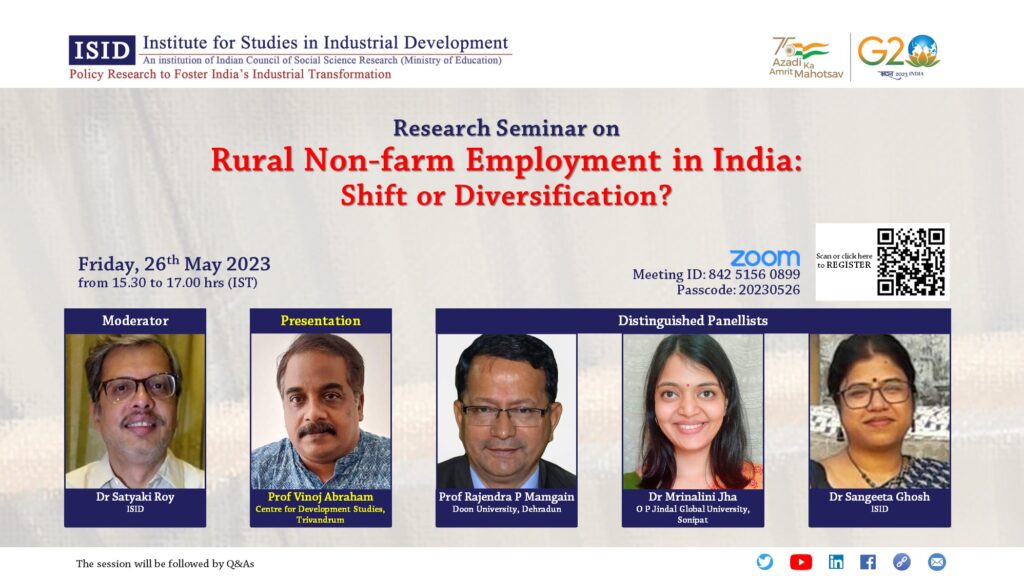
ISID organised a webinar on “Rural Non-farm Employment in India: Shift or Diversification?” on May 26, 2023. Prof Vinoj Abraham, Professor, Centre for Development Studies, Thiruvananthapuram made the presentation. The presentation was followed by a discussion by a panel of experts consisting of Prof Rajendra P Mamgain, Professor and Dean of Social Sciences, Doon University, Dehradun; Dr Mrinalini Jha, Assistant Professor, OP Jindal Global University, Sonipat; and Dr Sangeeta Ghosh, Assistant Professor, ISID. The webinar was moderated by Dr Satyaki Roy, Associate Professor, ISID.
Click here for the INVITE
Meeting ID: 842 5156 0899
Passcode: 20230526
Abstract: The rather slow transition in the rural employment from farm to non-farm sector in India is well documented. Non-agricultural employment in rural India stood at 39.2 percent against agricultural employment of 60.8 percent in 2020-21. Spanning over the last two decades the share of non-agricultural employment in rural India increased only by 15.5 percent. Structural transformation implies that with the growth of the urban industrial/service sector and its interlinkages with the rural economy, employment opportunities in the rural non-farm sector would enhance, and the rural labour market would tighten. This would cause a change in the employment pattern from farm to non-farm sectors.
However, evidences do suggest that economic growth in India has a narrow base, mostly propelled by a few sectors in the urban service sector in India with little interlinkages with the rural economy. The rural economy, even when continues to be the bulwark for food security in the country, its weak or absent markets and their integration imply that the growth impulses in the urban services are only weakly percolating to the rural markets. In this context, the movement in employment from agriculture to non-agriculture sector in the rural economy may occur as a risk reducing response to poor agricultural employment opportunities. Thus, diversification in employment would appeal to risk mitigation, as opposed to shift in employment from farm to non-farm which may be more akin to earnings maximization.
Shift and diversification are rural household employment strategies in response to economic impulses. Analytically, employment shift is a movement from one activity to another, in this case from farm to non-farm activity. Diversification is the spread to more than one activity, here farm and non-farm during the same period. Both Shift and Diversification could occur at the individual level and at the household level. The decision-making process in the rural context often being a joint decision making for the entire household, the shift and diversification can co-exist within households. Using this analytical frame of shift and diversification among individuals and households we analyse the nature of change in employment from agriculture to non-agriculture in rural India during the last two decades.
Firstly, we focus on the trends and patterns in the employment in the rural economy. Secondly, we dissect the change in non-farm employment into various categories of shifts and diversification in employment. Thirdly, drawing from structural transformation literature and livelihood literature we try to understand what are the impulses to which such change in rural employment is taking place.


